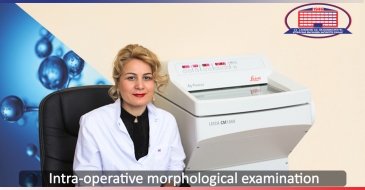Among the systemic blood diseases, lymphoma is one of the common nosology group.
To understand the disease, it is better to define the hematopoietic organ.
Hematopoietic organ consists of central and peripheral parts. Bone marrow and thymus (a gland behind the sternum) are central organs, peripheral organs are spleen, lymph nodes, mucosa-associated lymphoid tissue (MALT), and peripheral blood.
Cancers developing from the hematopoietic organs are called hemoblastosis. Lymphomas are part of the hemoblastosis group. It is the malignant proliferation of the hematopoietic organ. It is also called a tumor outside the bone marrow.
It comprises 4.1% of the oncology diseases in Georgia.
The head of the hematology department, doctor-hematologist Eka Imedashvili is talking with us.
- Dr. Eka, what is the cause of lymphoma?
- As for the other neoplastic diseases, the specific cause of lymphoma is not established.
It occurs in all age groups among adults. According to various studies, it is correlated with several viruses (Epstein-Barr, B, and C hepatitis), chlamydiosis, borreliosis. There are cases of lymphomas caused by Helicobacter.
Lymphomas caused by the prolonged exposure to the ionizing radiation and familial cases are also reported, but there is no specific cause established.
It should be noted that the course of the disease may be indolent or aggressive. Lymphoma is a pathology of the hematopoietic organ and according to the morphologic substrate, it is divided into two parts - Hodgkin lymphomas and non-Hodgkin lymphomas.
Hodgkin lymphoma sometimes is called as lymphogranulomatous. Very large, multinucleated cells are characteristic for lymphoma, 80% arise from the follicular germinal center of the lymph node, from the mature, slowly proliferating B lymphocytes. 20% arise (derive) from T cells. These called Hodgkin or Reed-Sternberg cells. They are carriers of mutations. Apoptosis (programmed cell death) is blocked in these cells. They also carry CD15 and CD30 receptors on their surface, meaning that they are cancer cells. These are also called immunologic markers and are criteria for differentiation and diagnosis of the disease.
As for non-Hodgkin lymphomas, there are 35 subtypes of the disease. According to the morphologic substrate, there are B and T lymphocytic lymphomas. According to the antigenic panel, expression of CD19, CD20, CD22, HLA/DR, CD5, CD10, CD38, CD23 antigens are characteristic for them. T-cell non-Hodgkin lymphomas express CD4, CD7, CD8 antigens.
According to the stage of the disease, there are I, II, III, IV, V stages. Hodgkin lymphoma is not characterized by the fifth stage.
According to the course of the disease and general symptoms, every stage has two forms – “A” when there are no symptoms and “B” when there are symptoms.
These symptoms include night sweats, weight loss, fever, skin itching.
- What are the symptoms of the disease?
- Enlargement of the cervical, supraclavicular lymph nodes, commonly on the right side. The lymph nodes are painless, soft, elastic. Patients frequently complain about the feeling of heaviness in the left upper quadrant of the abdomen and they notice enlarged spleen by the self-exam. Enlarged lymph nodes in the mediastinum create a feeling of suffocation. This problem is the main reason for seeking a doctor. The family doctor sends the patient to a hematologist because the diagnosis of the systemic hematology malignancy requires specific tests.
– How is the disease diagnosed at the National Center of Surgery and from where do you take the specimen?
– For the diagnosis, hematology and additional studies should be conducted. Paracentesis of the lymph node, biopsy, cytology, histomorphology, an immunophenotypic and immunohistochemical study of the specimen, bone marrow aspiration, trepano-biopsy, diagnostic splenectomy, determination of Lactate Dehydrogenase level, CT of the chest and abdominal cavity organs – to evaluate the stage of the disease and the effectiveness of the treatment.
- How do you treat lymphoma at the National Center of Surgery, what modern methods do you use?
-Treatment of lymphoma is performed surgically (for example, in the case of the lymphoma of the spleen-splenectomy), chemotherapy and radiotherapy. The chemotherapy regimen is based on international guidelines and protocols.
Recently, transplantation has been successfully used.
The National Center of Surgery carries out both surgical treatment and chemotherapy, the gold standard with R-CHOP-scheme.
Mabthera destroys CD20-positive cells by several mechanisms:
- Binds to the surface markers of CD20 cells. It causes antibody and complement-mediated cytotoxicity and an apoptosis.
- Increases the sensitivity of lymphocytes to the cytotoxic effect of chemotherapy.
After the MabThera infusion, chemotherapy starts.
We use different treatment regimens, the choice is based on the form of the disease, the stage, the prognostic factors (ASAP, ABVD, BEACOPP, BACOD-E, COMLA, ESAP, Pro-MACE-CytaBOM, DHAP), etc.
High-dose chemotherapy is also performed.
Treatment is carried out using an infusomat, which allows us to accurately determine the regimen of chemotherapy.
The goal of chemotherapy is to destroy cancer cells. The cytotoxic action of the drug also damages healthy cells. There comes a phase of drug-induced aplasia.
The situation can be determined in a timely manner at the National Center of Surgery. Conduct laboratory and instrumental studies. Transfusion and infusion therapy can be performed at any time of the day.
Remember that modern medicine allows us to diagnose the disease in the first and second stages, which increases the chances of cure.
National Center of Surgery address – Tbilisi, Digomi Chachava street N5.
You can contact the Call-center of the National Center of Surgery at 577 11 91 19 or 2 02 25 25;
If you have some questions, you can contact the head of the Hematology Department of the National Center of Surgery, Eka Imedashvili at 577 32 88 65;
Wish you health!








